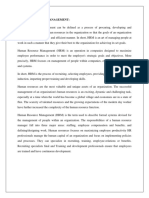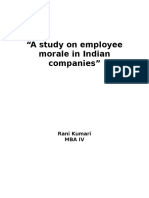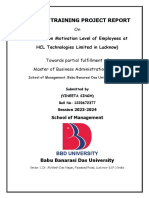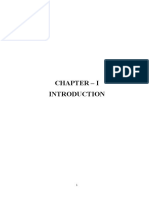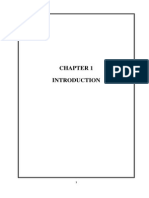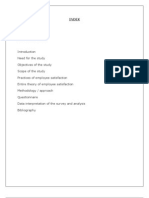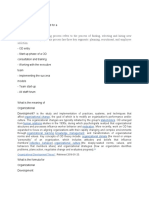CONCEPTUAL FRAME WORKS ON EMPLOYEE MORALE AND SATISFACTION IN WORK PLACE C 1169
CONCEPTUAL FRAME WORKS ON EMPLOYEE MORALE AND SATISFACTION IN WORK PLACE C 1169
Uploaded by
Ani AryaCopyright:
Available Formats
CONCEPTUAL FRAME WORKS ON EMPLOYEE MORALE AND SATISFACTION IN WORK PLACE C 1169
CONCEPTUAL FRAME WORKS ON EMPLOYEE MORALE AND SATISFACTION IN WORK PLACE C 1169
Uploaded by
Ani AryaOriginal Title
Copyright
Available Formats
Share this document
Did you find this document useful?
Is this content inappropriate?
Copyright:
Available Formats
CONCEPTUAL FRAME WORKS ON EMPLOYEE MORALE AND SATISFACTION IN WORK PLACE C 1169
CONCEPTUAL FRAME WORKS ON EMPLOYEE MORALE AND SATISFACTION IN WORK PLACE C 1169
Uploaded by
Ani AryaCopyright:
Available Formats
Vol-1 Issue-1 2016 IJARIIE-ISSN(O)-2395-4396
International Conference on "Innovative Management Practices” Organize by SVCET, Virudhunagar
CONCEPTUAL FRAME WORKS ON
EMPLOYEE MORALE AND
SATISFACTION IN WORK PLACE
P.Kandhakumar1 , DR. J. Isaac Balasingh2
1
Assistant Professor, Department of Management Studies, Einstein College of Engineering, Tirunelveli, Tamilnadu.
2
Professor, Department of Management Studies, G.U. Pope Engineering College, Sevaiyarpuram, Tamilnadu.
ABSTRACT
It is a universally accepted truth that morale of the employees is a factor which plays a vital role in the productivity
of an organization. The morale of the employees is a dependent factor which influences employee’s satisfaction and
employee’s performance thereby. This conceptual article attempts to describe the factors influencing employees
moral and various researchers’ contribution towards morale factors in work place. This article finds scope to
undergo further research and also aims to understand the relationship between moral e, employee satisfaction and
employee performance. In this article the researcher tries to understand the contribution of various views, opinions
and ideas related to morale of the employees. The conclusion part of this research shall be implemented in
organizations for the betterment of the employees and to improve their satisfaction level.
Keywords: Morale, Motivation, Organization, Performance and Satisfaction .
1. INTRODUCTION
Morale is the most important Psychological state of mind of a person which is expressed as self-
confidence, loyalty toward an organization and/or enthusiasm. Morale of an employee determines the behavior
either positively or negatively in an organization. Morale is directly related to employee motivation level and
satisfaction in their job. Morale ultimately reflects in the performance of the employee and leads to retention.
Morale can be defined as a person's attitude towards being part of a group or organization. It reflects the satisfaction
and sense of achievement that they get from being part of the group. High morale means the interest in being part of
the group and a possible desire to do something else.
Today each and every organization is trying to maintain positive morale among its employees, because employees
with positive morale performs better, reveal low rate of absenteeism, low wastages, high productivity and tend to
behave in a loyal manner. Similarly the employees with negative morale tend to behave negatively. It is understood
that the satisfied employees in an organization are with high morale. Moreover low morale employees can cause
threat such as high employee turnover and drop in productivity. Hence it is very important to understand the factors
that affect morale in an organization and rectify those factors.
2. INDICATORS OF MORALE
1. Increase in absenteeism
2. Lack of interest towards maintaining standards of tidiness and cleanliness of the premises.
3. Low degree of turnout, alertness for directions /command and low enthusiasm.
4. Increase in in-disciplinary activities and increased "answering back".
5. Decrease in achievement levels of the employees.
Considering the above factors the organization should develop positive morale among employees. Therefore the
following factors shall be considered to establish positive morale employees in an organization.
C-1169 www.ijariie.co m 312
Vol-1 Issue-1 2016 IJARIIE-ISSN(O)-2395-4396
International Conference on "Innovative Management Practices” Organize by SVCET, Virudhunagar
3. WAYS TO ESTABLISH POSITIVE MORALE
i. Selecting right people initially:
Instead of motivating the employees after recruiting, the companies should recruit highly positive employees with
good attitude and employees with interest towards their job and achievements. An effective interview system to
identify right candidate is very essential. Even good leadership, good management style and good interpersonal
relationship will not work if wrong employees were hired.
ii. Understandi ng the motivating factors in better manner:
The management has to understand the factors motivating each employee in an organization. The management
should pay special attention in identifying the factors motivating the employees; they shall compare their motivation
and the performance then and there.
iii. Motivati on factors for continually changing and long lasting:
The morale change should be continuous and long term change which will help the organization’s growth; hence the
management shall focus on permanent change. The company should realize that e ach and every individual employee
has different likings and disliking’s and different motivational factors.
iv. Attractive work atmosphere:
The company should offer an appropriate work hour, workloads, attractive monetary benefits, accountability and
good career growth.
v. Better Intrinsic rewards:
Among all rewards system the company should pay more attention on intrinsic rewards. Attractive Incentives and
bonus plans shall motivate the employees to be more close to the management.
vi . Good communication to develop management and employee relationship:
Adequate communication to maintaining good employee and boss relationship is essential. Good communication
will build good repot between employee and employees, employees and management.
vii. Vision and common team goals to create overall good business environment:
The company shall create vision and common goal to employees which shall bring good binding to the employees
towards the organization. Only a good working environment can create a sustainable morale among the employees.
viii. Respect and recognition of employee interest:
The company should treat the employees with respect and recognize the effort of them. Only then the employees
will be happy with the management and their morale level will be positive.
ix. Happiness in personal life:
Not only organization factors are influencing employees morale also the personal factors also influences the morale
of the employees, the few personal factors influencing the employees are spouse, children, friends, extended family,
health, financial, etc. Similarly the travel from home to work place should be reasonable and not tired some. A
balance work life and employees with quality of life are also found with morale. Hence the company should develop
the quality of life of the employees.
x. Establishment of good relationship:
The management should enhance good relationship among employer and employees and between employees. The
relationship among the employees is one of the major reasons for employee retention . Good companies pay special
attention on betterment of the relationship and they ensure effective communication system among the employees.
xi. Ensuring discipline and sincerity:
Generally it is understood that the companies were the employees are more disciplined and sincere the morale is
high. Therefore the management should discipline and sincerity among the employees.
3. MORALE AND SATISFACTION
Job satisfaction can be defined as an individual’s general attitude toward his or her job (Robbins et al. 2003).
Similarly Cranny et al. (1992) defined job satisfaction as an affective (emotional) reaction to a job that results from
the incumbent’s comparison of actual outcomes with those that are desired .
Locke (1976) gives a comprehensive definition of job satisfaction as “a pleasurable or positive motional estate
resulting from the appraisal of one’s job experience.” Job satisfaction is a result of employee’s perception of how
well their job provides those things that are viewed as important. It is generally recognized in t he organizational
behavior field that job satisfaction is the most important and frequently studied attitude. There are three important
dimensions to job satisfaction as follows (Locke 1976) Job satisfaction is an emotional response to a job situation.
As such, it cannot be seen; it can only be inferred. Job satisfaction is often determined by how well outcomes meet
or exceed expectations. For example, if organizational participants feel that they are working much harder than other
C-1169 www.ijariie.co m 313
Vol-1 Issue-1 2016 IJARIIE-ISSN(O)-2395-4396
International Conference on "Innovative Management Practices” Organize by SVCET, Virudhunagar
in the department but are receiving fewer rewards, they will probably have a negative attitude toward the work, the
boss and/or coworkers and they will be dissatisfied. On the other hand, if they feel that they are being treated very
well and are being paid equitably, they are likely to have a positive attitude toward the job and then they will be job
satisfied.
A satisfied employee tends to be absent less often, to make positive contributions and to stay with the organization
very eagerly (Hakim 1993). But a non-satisfied employee may be absent more often, may experience stress that
disrupts co-workers, and may be continually looking for another job. Contrary to what a lot of managers believe,
however, high levels of job satisfaction do not necessarily lead to higher levels of pro ductivity. One survey indicated
that, also contrary to popular opinion, Japanese workers are less satisfied with their jobs than their counterparts in
the USA (Lincoln 1989).
This measure is basis itself on five facets of job satisfaction. The first facet is the work itself, satisfaction with work
itself is measured in terms of the core job characteristics such as autonomy, skill variety, feedback, task identity, and
task significance (Hackman and Oldham 1975). Supervision, the second facet, is measured in such ways as how
supervisors provide feedback, assess employees’ performance ratings, and delegate work assignments. Co -workers,
the third facet, are measured in terms of social support, networking, and possible benefits attached to those
relationships (Cranny et al. 1992).
Pay, the fourth facet, is an important source of satisfaction because it provides a potential source of self-esteem as
well as the generic opportunity for anything money can buy (Brockner 1988). Obviously satisfaction with pay is
measured primarily by current income but also by opportunities for salary increases. Promotion is the final facet and
the one that the JDI explicitly assesses how perceptions about the future can affect job satisfaction. Today the facets
of the JDI are generally assessed by modifying the adjective checklist and using a Likert scale on statements such as,
“opportunities for advancement are plentiful” measured from one (strongly disagree) to five (strongly agree)
(Cranny et al. 1992).
4. FACTORS INFLUENCING MORALE AND SATISFACTION
Bardwick (1996) connects leadership and trust with wartime leadership experiences to peacetime conditions. What
people see, hear, and experience as being true forms trust. When communication is weak or does not exist, trust is
lost to confusion and cynicism. There is a decline in morale and confidence in leadership and organizational beliefs
fade. To gain trust, there must be integrity. Bardwick continues that there must be respect for one another.
Everyone's input is needed. Good leaders do not consider input as demeaning. "Hearing others, like empowering
others, isn't a matter of process, it is instead, a matter of respect" (p.153). Bardwick (1996) notes that leaders inspire
confidence and understand that inaction may increase feelings o f anxiety, powerlessness, and insecurity. When
ability is doubted, confidence and effectiveness are damaged. Leaders are perceived as being able to make things
better. Leaders overcome fright with confidence, vacillation with certainty, hesitation with act ion, weakness with
strength, floundering with expertise, cowardice with courage, cynicism with optimism, and despair with a conviction
that the future will be better.
According to Heskett et al (1994), more satisfied employees, stimulate a chain of positive actions which end in an
improved company performance. In another research it is said that employee satisfaction influenced employee
productivity, absenteeism and retention, Derek R. Allen & Merris Wilburn, (2002).
Alam Sageer, Dr. Sameena Rafat and Puja Agarwal (2012), in their study have concluded that employee attitudes
typically reflect the moral of the company. In areas of customer service and sales, happy employees are extremely
important because they represent the company to the public. So, every organization should develop strategies that
strengthen the work environment and increase the employee morale and employee satisfaction to enhance employee
performance and productivity, which ultimately results in high profits, customer satisfaction as well as customer
retention.
5. IMPACT OF MORALE AND SATISFACTION ON EMPLOYEES PERFORMANCE
Duncan N. Nyaberi & Aloys Nyagechi Kiriago (2013), conducted their research with the motive to determine how
retrenchment in Telkom Kenya has affected the morale of emp loyees and to determine how retrenchment process
has affected job security of surviving staff. The study adopted the descriptive survey research design. Descriptive
research portrays an accurate profile of persons, events, or situations. Surveys allow the collection of large amount
C-1169 www.ijariie.co m 314
Vol-1 Issue-1 2016 IJARIIE-ISSN(O)-2395-4396
International Conference on "Innovative Management Practices” Organize by SVCET, Virudhunagar
of data from a sizable population in a highly economical way. It allows one to collect quantitative data which can be
analyzed quantitatively using descriptive and inferential statistics (Saunders et al., 2007). Therefore, the de scriptive
survey was deemed the best strategy to fulfill the objectives of this study. A stratified random sampling technique
was employed to select the respondents since a stratum is a subset of a population that shares at least a common
characteristic. The researcher first identified the relevant stratums (the managers and the support staff), and their
actual representation in the population. Random sampling was then used to select a sufficient number of subjects
from each stratum.
Out of the population of 185 managers, 19 were selected for the sample while 93 were selected from the population
of 935 support staff in the company. This gave a total sample size of 112 respondents. From the study, the researcher
concluded that retrenchment in Telkom Kenya greatly affected the morale of employees. This was due to the fact
that since other employees were laid off, the majority of the surviving employees feel more traumatized at the
workplace.
The study also concludes that the retrenchment process has greatly affected the job security of the surviving staff.
This is because from the study, the majority of the employees did not feel secure working in Telkom Kenya and
given a chance, they would leave for the organization for another opportunity elsewhere.
Raju and Srivastava (1994) performed a study on the factors contributing to commitment to the teaching profession
on 454 teachers in Delhi, India. Their goal was to test for the intercorrelations between 18 psychosocial predictors.
These predictors were external expectations; desire to utilize skills, religiosity, and intrinsic motivation, inner
direction, self-accountability, perceived status, perceived advancement, perceived challenge, interest in the
profession, social support, group attitudes, choice satisfaction, other job opportunities, overall job satisfaction,
teaching role salience, intention to stay with the profession, and desire for skill improvement.
The results showed that committed teachers exhibited the following tendencies:
1. Perceived that the teaching profession enjoys a high social status and felt proud of being teachers;
2. Generally showed more interest in teaching and professional activities;
3. Considered there was scope for vertical mobility within the profession;
4. Found more conducive and positive attitudes to teaching among their colleagues and other teachers;
5. Received both direct and indirect support in their teaching endeavors from significant others.
Lee and Busch (2005) conducted a study on what motivates instructors to participate in distance education (DE).
They found a strong correlation between willingness to teach DE and the amount of training received, a strong
correlation between willingness to teach DE and students' evaluation of the course, and also a strong correlation
between willingness to teach DE and students' evaluation of instructor. There was not a significant correlation
between willingness to teach DE and the instructors opinions that creating a DE course involved more effort than a
face to face course. This would tend to show that these instructors were motivated by good training and preparation
and by the acknowledgement of a job well done given by the students. The added work involved was not a de -
motivator for the instructors.
Linda (1998), Babajide (2001) and Ajala (2004) report that the leadership style and communication climate in
organization has significantly influenced workers’ morale. In essence, the level of workers’ participation and
involvement in making decisions that affect organizational interes t tend to influence their morale. This implies that,
knowledge and level of awareness of workers on issues and problems affecting organization where they have
invested their talents and skills could also affect their morale, job satisfaction, and intention to stay or quit an
organization.
Dayo Akintayo (2012) has observed that conducive working environment and workers` morale have significantly
contributed to perceived workers’ productivity in industrial organizations in South -West Nigeria. In essence,
working environment tends to influence the morale of the workers vis - a- vis their productivity at varying degrees
depending on the types of organization. The implication of the findings is that for promotion of workers improved
morale and their productivity at workplace, there is a need for conducive working environment which involves
effective organizational support programmes, job incentives, training and development programmes, flow of
information across board for sustainable goal achievement. Also, for e ffectiveness and efficiency on the job,
appropriate strategies for promoting the workers’ morale and productivity need be entrenched in the cardinal goals
of the organization. The management style of the managers needs to foster workers’ participation in d ecision making
C-1169 www.ijariie.co m 315
Vol-1 Issue-1 2016 IJARIIE-ISSN(O)-2395-4396
International Conference on "Innovative Management Practices” Organize by SVCET, Virudhunagar
process in order to boost their morale, efficiency and productivity in any work organization. Based on the findings
of the study; the following recommendations are made: The working environment which tends to attenuate the
organizational support programmes, provision of adequate pension payment, substantive welfare package and
provision of adequate pension schemes for workers should be provided. This will definitely facilitate improved
workers’ morale and productivity in work organizations. The physical social infrastructures and political climate of
the organizations should be friction free. In essence, democratic style of management that could be people - oriented
and production- oriented should be adopted by the managers in managing organizational resources. This will afford
the workers opportunity to participate actively in decision making process and virtually sustain their interest, morale
and productivity at workplace. Training and development programmes that could build the capacity of t he workers
in terms of updating their skills and knowledge of the jobs towards adjustment to changes in working environment
should be introduced on regular basis in order to boost their morale and virtually fostered improved productivity
among the workforce.
i. Is there a relationship between the morale and productivity of an employee?
Yes, the literature review unequivocally supports the idea, that morale as an independent variable has a direct impact
on the dependent variable productivity. The data from the T.F.D. District 4 "C“ Platoon indicates a measurable
increase in productivity coupled with clear indicators that members have experienced an increase in morale. Based
on the available data and the reasonableness of the question, we can answer this quest ion in the affirmative.
ii. Can productivity increase within an employee group by increasing employee morale?
Yes, Both data and literature support the theory that an increase in the independent variable X, morale, will provide
a commensurate increase in the dependent variable Y, employee productivity. Sufficeth to say at some point there
will be an obvious point of diminishing return. One could not continue to indefinitely increase morale and expect a
corresponding return.
iii. What measures can a supervisor take to improve employee morale?
As was mentioned in both literature review and the survey, positive reinforcement, employee input, feedback, and
empowerment are essential components to increase morale. Supervisors all the way up the chain of command as
well as co-workers have influence in this area.
Devina Upadhyay & Anu Gupta (2012), observed that more than 50 % respondents are working with more than 10
years out of that only 14 % morale of the people was high, 46% are satisfied with the work given to them and 66%
employees are satisfied with the welfare measures given to them. Thus we can say that there is no role of work
experience in employee satisfaction and thus with employee morale. 2. Work satisfaction is not independent to
communication at work place, 3. Work satisfaction is independent of welfare and work experience. 4. Motivation
given to employee and work satisfaction are not independent to each other. 5. There is no significant impact of
welfare measures on employee morale 6. There is a positive correlation between work satisfaction and morale of an
employee. In regard to the above observation the researcher has recommended that the organization shall provide
adequate welfare measures but should not burden itself by increasing the cost part of it in greed to earn the
competitive edge and declare itself as most desired company. Other factors like good and open communication,
providing motivating factors, empowerment etc should be taken into consideration for increasing the employee
satisfaction level. The research also shows that there is association between satisfaction and morale of an employee
therefore to build an employee morale company should go for building employee satisfaction. The myth that
longevity gives more satisfaction to the job is als o eroded from this research as experience and satisfaction were
found to be independent.
Robbin( 2003) advocated removing de motivation and improving welfare practices as per demographic profile of the
workers to address the issue of low morale. Steven (2009) identified other factors like no career or succession
planning and delegation of authority, lack of communication as other reasons for low morale. Similarly negligent
welfare practices, inflexible working condition, lack of confidence in management lay off conflicts, high employee
turnover, and role ambiguity are other reasons for low morale.
Upadhyay and Gupta (2012) conclude that communication plays a major role in increasing the satisfaction of an
employee. Satisfied employees are reported to have high morale. Welfare measures and work experience does not
necessarily relates to satisfaction .Therefore its recommended that company should provide for adequate welfare
measures but should not burden itself by increasing the cost part of it in greed to earn the competitive edge and
C-1169 www.ijariie.co m 316
Vol-1 Issue-1 2016 IJARIIE-ISSN(O)-2395-4396
International Conference on "Innovative Management Practices” Organize by SVCET, Virudhunagar
declare itself as most desired company. Other factors like good and open communication, providing motivating
factors, empowerment etc should be taken into consideration for increasing the employee satisfaction level.
Ngamb(2013) revealed that there is a relationship between leadership and morale, and those leadership
competencies such as communication, fostering trust and team building set a clear direction for the college impact
on morale. It is recommended that morale surveys should be conducted to obtain the requisite information before
developing strategies that relate to employee morale, retention and performance. Zial (2011) concluded is that
teambuilding has long term positive relationship between employee morale and employee retention. Team
performance, individual contribution, team evaluation and coordination have long term positive relationship
between employee morale and employee retention. Team unity has no significant effect on employee morale and
employee retention.
Employee morale within an organization has a direct impact on the satisfaction level of its cus tomers and the
company's ultimate success. When relationship-based leaders promote core competency development of its
workforce throughout the organization, an opportunity exists for ensuring high employee morale and customer
satisfaction, an increase in employee and customer retention rates, and a positive long -term outlook for the
company's successful performance Barbara (2002).
Dr.Usha Tiwari, (2014), has undergone a research with the objective to assess the level of morale of the employees
of Jaypee Cement Plant Rewa, to find the various factors leading to employee’s morale in the organization, to
evaluate the impact of employee morale on their efficiency and to suggest measures for improve morale of the
employees of organization. The researcher decided to measure the Employees morale and its impact on employee’s
efficiency 18 items questionnaire was administrated to the selected respondents. The scoring was analyzed on five
point scale and score was simplified in percentage as per the formula of Rao (1991). The researcher has found that
the employees morale and its impact on employees efficiency at. Jaypee Cement Plant Rewa , appears Good. The
average mean score and percentage score has been computed at 3.60(65%). The most important factor contributing
employees morale are: relationship with the fellow workers, team spirit in direct work environment ,working
condition of work place ,leaves and holidays provided, management and employees are allowed to talk freely.
Few suggestions were suggested by the researcher, they are as follows; Clear and timely communication and
feedback. 2. Defining goals and direction of the work unit and company. 3. Defining and reinforcing clear lines of
authority, responsibility and accountability. 4. Rewarding and recognizin g positive performance and addressing
negative or limited performance in a timely manner. 5. Identifying gaps in knowledge and providing focused,
individualized training. 6. Reducing unrealistic fears and anxieties regarding job security. 7. Encouraging kn owledge
and specific skill building in all dimensions of the core competencies which impact the overall performance of the
company. 8. Allowing employees to rehearse newly acquired competencies.
6. SCOPE FOR FUTURE RESEARCH
There are many researcher focuses the morale factors of employees, motivation of employees, employee
satisfaction, impact of morale on performance of employees and similarly there are researches on employee
satisfaction and employee performance. The researcher also observes the scope for studying the relationship
between and impact of morale on satisfaction and employee performance.
7. CONCLUSION
The morale is the psychological factor which results in positive behavior of the employees and the positive behavior
results effective performance. This article concludes that morale is the prime factor which results in effective
performance of an organization.
8. REFERENCE
1. Ajala MO (2004). A survey of workers’ attitude to work in industrial organizations in Lagos State.
Unpublished MSC Project, University of Lagos, Lagos.
2. Alam Sageer, Dr. Sameena Rafat and Puja Agarwal (2012), Identification of Variables Affecting Employee
Satisfaction and Their Impact on the Organization, Journal of Business and Management, ISSN: 2278-
487X. Volume 5, Issue 1 (Sep-Oct. 2012), PP 32-39.
3. Babajide, P. H. (2001). Analysis of work place attitude and behaviour; A Case study of Nigerian Breweries
Plc. Unpublished MSC Project, University of Ibadan, Ibadan.
C-1169 www.ijariie.co m 317
Vol-1 Issue-1 2016 IJARIIE-ISSN(O)-2395-4396
International Conference on "Innovative Management Practices” Organize by SVCET, Virudhunagar
4. Barbara J. Fretwell,(2002): Promoting Organizational Competency: A Solution To Increasing Employee
Morale And Customer Satisfaction. CERES Innovations, pp.1-9.
5. Bardwick, J. M. (1996). Peacetime management and wartime leadership. In Frances Hesselbein, Marshall
Goldsmith, and Richard Beckhard (Eds.), The leader of the future (pp. 131-139) New York: The Drucker
Foundation.
6. Brockner, J. (1988), Self Esteem at Work: Research, Theory and Practice, Lexington, MA: Lexington
Books.
7. Cranny, C. J.; Smith, P. C. and Stone, E. F. (1992), Job Satisfaction, Lexington Books: New York.
8. Dayo Akintayo, (2012), Working environment, workers’ morale and perceived productivity in industrial
organizations in Nigeria, Education Research Journal Vol. 2(3) pp. 87-93.
9. Derek R. Allen, Merris Wilburn, (2002) –Linking customer and employee satisfaction to the bottom line,
ASQ quality press publications cat log, Milaukee, WI.
10. Devina Upadhyay & Anu Gupta (2012), Morale, Welfare measures, Job Satisfaction: The Key Mantras for
Gaining Competitive Edge, International Journal of Physical and Social Sciences, P 91.
11. Dr.Usha Tiwari, (2014), A Study on Employee Morale And Its Impact On Employee Efficiency At Jaypee
Cement Plant Rewa (M.P.), Abhinav International Monthly Refereed Journal of Research in Management
& Technology, Volume 3, Issue 11 (November, 2014)
12. Duncan N. Nyaberi & Aloys Nyagechi Kiriago (2013), Effects of retrenchment on the morale and job
security of surviving employees of Telkom Kenya Limited, International Journal of Academic Research in
Business and Social Sciences, September 2013, Vol. 3, No. 9 ISSN: 2222-6990
13. Greg H. Neely (1999), the Relations hip between Employee Morale And Employee Productivity, An
Applied Research Project Submitted To The National Fire Academy As Part Of The Executive Fire Officer
Program pp - 11
14. Hackman, J. R. and Oldham, G. R. (1975), Development of the Job Diagnostic Survey, Journal of Applied
Psychology, 60: 159-170.
15. Hakim (1993), Boost Morale to Gain Productivity, HR Magazine, February: 46-53.
16. Heskett, J. L., T. O. Jones, G. W. Loveman, W. E. Jr. Sasser, L. A. Schlesinger. 1994. Putting the service -
profit chain to work, Harvard Business Review 72 (2).
17. Lee, J.A., & Busch, P.E. (2005), Factors related to instructors' willingness to participate in distance
education. Journal of Educational Research, 99(2), 109-115.
18. Lincoln, J.R. (1989), Employee Work Attitudes and Management Practice in the U.S and Japan: Evidence
from a large comparative study, California Management Review: 89-106.
19. Linda, J. T (1998). Workers’ morale, motivation and performance effectiveness survey in single sex
dominated organizations. Journal of Applied Psychology, 16(2), 36-43.
20. Locke, E.A. (1976), the Nature and Cause of Job Satisfaction, in M.D. Dunnette (ed.), Handbook of
Industrial and Organizational Psychology, Rand McNally, Chicago: 1297-1349.
21. Ngamb H. C.(2011): The relationship between leadership and employee morale in higher education.
African Journal of Business Management Vol. 5(3), pp. 762-776.
22. Raju, P.M., & Srivastava, R.c. (1994). Factors contributing to commitment to the teaching profession
[Electronic Version]. The International Journal of Educational Management, 8(5), 7-13.
23. Robbins, S.P.; Odendaal, A. and Roodt, G. (2003), Organisational Behaviour, Global and Southern African
Perspectives. Cape Town, Pearson Education.
24. Stevens D (2009). The five causes of low employee morale—and how-to avoid them. Available:
http://www.humanresourcesiq.com [2010, May, 19]
25. Thornhill, A., Saunders, M., and Stead, J., (1997) Downsizing, delayering –but where is the commitment?
Development of a diagnostic tool to help manage survivors, Personnel Review, 26 (1/2), 81-98.
26. Zia1 Sayma (2011): Effects of organizational team building on employees' morale & job retention.
Business Management Dynamics Vol.1(.7) pp.31-37
C-1169 www.ijariie.co m 318
You might also like
- ETL Design TemplateDocument14 pagesETL Design TemplateachvmNo ratings yet
- The Study On Job Satisfaction of Reliance Ltd.Document41 pagesThe Study On Job Satisfaction of Reliance Ltd.Shivraj ghodeswar0% (1)
- Slab Design ExcelDocument6 pagesSlab Design ExcelsahmeduNo ratings yet
- Gold Cyanide SolutionDocument2 pagesGold Cyanide SolutionWalmir CristinoNo ratings yet
- Job Satisfaction:: Sindhi Institute of ManagementDocument61 pagesJob Satisfaction:: Sindhi Institute of ManagementVageesh p kNo ratings yet
- Job Satisfaction ProjectDocument8 pagesJob Satisfaction ProjectSwetha Reddy Lingala100% (2)
- A Study On Work Life Balance of Employee in OrganizationDocument9 pagesA Study On Work Life Balance of Employee in OrganizationeswariNo ratings yet
- Project 1Document97 pagesProject 1MEENA VNo ratings yet
- Attitudes & Job SatisfactionDocument61 pagesAttitudes & Job SatisfactionVine Grace MartinNo ratings yet
- Part B 1sp17mba20Document71 pagesPart B 1sp17mba20jeevan mathiNo ratings yet
- Employee EngagementDocument55 pagesEmployee Engagementkrishna saiNo ratings yet
- Icic BankDocument29 pagesIcic Bankjassi7nishadNo ratings yet
- An Organization Study Report of BERGER PAINTS INDIA LTDDocument10 pagesAn Organization Study Report of BERGER PAINTS INDIA LTDMohanGuptaNo ratings yet
- Neha Innovation 1Document10 pagesNeha Innovation 1Neha DeshmukhNo ratings yet
- Impact of Employee Engagement On Organizational Success: A Study in TATA Advanced Materials Limited, BengaluruDocument6 pagesImpact of Employee Engagement On Organizational Success: A Study in TATA Advanced Materials Limited, Bengalurunyan hein aungNo ratings yet
- HRM CAMPUS ExperienceDocument15 pagesHRM CAMPUS ExperiencemadhurikachintaNo ratings yet
- Model Answer ULMODocument9 pagesModel Answer ULMOAzra IshratNo ratings yet
- A Study On Job-Satisfaction of EmployeesDocument23 pagesA Study On Job-Satisfaction of EmployeesMullasseril Justin Joy (O-SCM 19-21)No ratings yet
- Review of LiteratureDocument47 pagesReview of LiteratureAnil BaroliaNo ratings yet
- Employee Motivation EditDocument29 pagesEmployee Motivation EdityellowishmustardNo ratings yet
- Employee Morale and Employee Retention: IPASJ International Journal of Management (IIJM)Document2 pagesEmployee Morale and Employee Retention: IPASJ International Journal of Management (IIJM)International Journal of Application or Innovation in Engineering & ManagementNo ratings yet
- A Study Report in Work Motivation On Organisational Behaviour Under Business AdministrationDocument23 pagesA Study Report in Work Motivation On Organisational Behaviour Under Business AdministrationNirmal GovindarajuNo ratings yet
- "A Study On Employee Morale in Indian Companies": Rani Kumari Mba IvDocument11 pages"A Study On Employee Morale in Indian Companies": Rani Kumari Mba IvAnonymous kfPZ5DNo ratings yet
- Group 8 Ob AssignmentDocument25 pagesGroup 8 Ob AssignmentMd ShakilNo ratings yet
- A Study On Analyzing Levels Of: Master of Business AdministrationDocument107 pagesA Study On Analyzing Levels Of: Master of Business AdministrationTanuja JhaNo ratings yet
- Synopsis - Employee EngagementDocument17 pagesSynopsis - Employee EngagementJagshish SinghNo ratings yet
- A Study On Motivation Level of Employees at HCL Technologies Limited in LucknowDocument113 pagesA Study On Motivation Level of Employees at HCL Technologies Limited in LucknowHarshit KashyapNo ratings yet
- Employee MoraleDocument69 pagesEmployee MoraleNitin Kumar100% (2)
- Employee SatisfactionDocument107 pagesEmployee SatisfactionDhatriIndia100% (1)
- Swethasri. Research Final EditedDocument54 pagesSwethasri. Research Final Editedswetha sriNo ratings yet
- Employee SatisfactionDocument44 pagesEmployee SatisfactionYeshwanth ThotamsettyNo ratings yet
- Chapter-2 Objectives, Significance and Limitations of The StudyDocument4 pagesChapter-2 Objectives, Significance and Limitations of The StudyAgam ShatodarNo ratings yet
- Job Satisfaction Case StudyDocument5 pagesJob Satisfaction Case StudyPihu Sharma100% (1)
- IntoductionDocument3 pagesIntoductionSriii INo ratings yet
- Anchal SinghDocument22 pagesAnchal SinghMohmmed KhayyumNo ratings yet
- Introduction of Job SatisfactionDocument5 pagesIntroduction of Job SatisfactionVijay Vinzuda100% (1)
- Employee Engagement at DR Reddy's FinalDocument89 pagesEmployee Engagement at DR Reddy's Finalahmed100% (2)
- Employee EngageDocument77 pagesEmployee EngagecomicpogoNo ratings yet
- Conceptual FrameworkDocument10 pagesConceptual FrameworkafeefNo ratings yet
- 2.1 Motivational Factors of Employees Retention and Engagement in OrganizationsDocument6 pages2.1 Motivational Factors of Employees Retention and Engagement in OrganizationsChinmaya GuptaNo ratings yet
- Kokila MbaDocument56 pagesKokila MbaSanthiya AnanthNo ratings yet
- Employee RelationsDocument15 pagesEmployee Relationskareena shahNo ratings yet
- "A Study On Impact of Motivation On Employee Performance": Met College of Management StudiesDocument10 pages"A Study On Impact of Motivation On Employee Performance": Met College of Management StudiesDevaNo ratings yet
- Organizational BehaviorDocument14 pagesOrganizational Behaviorkakulsharma2005No ratings yet
- Organisational Behaviour - Concept, Nature, Scope and ImportanceDocument3 pagesOrganisational Behaviour - Concept, Nature, Scope and Importanceraiarya3406No ratings yet
- Employee EngagementDocument10 pagesEmployee EngagementKranthi kumarNo ratings yet
- Attitude and Job Satisfaction MOD ReportDocument16 pagesAttitude and Job Satisfaction MOD ReportSafi SheikhNo ratings yet
- Amul 1Document49 pagesAmul 1Sadhana SinghNo ratings yet
- Employee MotivationDocument29 pagesEmployee MotivationyellowishmustardNo ratings yet
- .... Employee Satisfaction Hetero DrugsDocument82 pages.... Employee Satisfaction Hetero Drugsmoula nawazNo ratings yet
- Job Satisfaction in TravancoreDocument75 pagesJob Satisfaction in TravancoreSathish Ssathish100% (3)
- Emplyee EngagementDocument13 pagesEmplyee EngagementShimaa Abou SreeNo ratings yet
- Employee SatisfactionDocument106 pagesEmployee SatisfactionPatan Najeema100% (3)
- Subject - Human Resource Management Subject Code - BTEC 913 Semester - 7 Tutorial Sheet No.2Document12 pagesSubject - Human Resource Management Subject Code - BTEC 913 Semester - 7 Tutorial Sheet No.2Anonymous VP98Qu9F3No ratings yet
- Dissatisfaction of EmployeesDocument9 pagesDissatisfaction of EmployeesrashidNo ratings yet
- Kritika Impact On Organizational Success and Its Employee EngagementDocument11 pagesKritika Impact On Organizational Success and Its Employee EngagementKritikaNo ratings yet
- Job SatisfactionDocument19 pagesJob SatisfactionSafi SheikhNo ratings yet
- Organizational Development NotesDocument23 pagesOrganizational Development Notesabdua miguel jrNo ratings yet
- OBECA1Document8 pagesOBECA1efraimloide9No ratings yet
- Promoting Healthy Workplaces: Well-Being Insights for Leadership, Engagement, and ProductivityFrom EverandPromoting Healthy Workplaces: Well-Being Insights for Leadership, Engagement, and ProductivityNo ratings yet
- Ways to Motivate Employees: The Happier and More Motivated the Employee, the Happier the Customer, the Healthier the Bottom LineFrom EverandWays to Motivate Employees: The Happier and More Motivated the Employee, the Happier the Customer, the Healthier the Bottom LineNo ratings yet
- Build Your Organization from the Inside-out: Developing People Is the Key to Healthy LeadershipFrom EverandBuild Your Organization from the Inside-out: Developing People Is the Key to Healthy LeadershipNo ratings yet
- 2nd PU Political Science Model QP 3Document7 pages2nd PU Political Science Model QP 3Prasad C M67% (9)
- Earthbag Building Blog - Sharing Information and Promoting Earthbag BuildingDocument5 pagesEarthbag Building Blog - Sharing Information and Promoting Earthbag BuildingDmt AlvarezNo ratings yet
- PM3000 Algebraic and Transcendental Functions: Teacher: Carlos Humberto Ruiz Pineda EmailDocument23 pagesPM3000 Algebraic and Transcendental Functions: Teacher: Carlos Humberto Ruiz Pineda EmailCarlos H RuizNo ratings yet
- The French RevolutionDocument2 pagesThe French RevolutionRupjyotiNo ratings yet
- Revision by Rev No Rev Mark Revision Description Revision DateDocument1 pageRevision by Rev No Rev Mark Revision Description Revision Dateedn_mj1645No ratings yet
- Generating Leads - A Little Known Fast & Powerful Method of Generating Quality Organic LeadsDocument16 pagesGenerating Leads - A Little Known Fast & Powerful Method of Generating Quality Organic LeadsIkechukwuNo ratings yet
- Economics of Finance (U6022) Homework Assignment #2 Tracking A Hedged Options Portfolio Over Time Due: October 23, 2002Document3 pagesEconomics of Finance (U6022) Homework Assignment #2 Tracking A Hedged Options Portfolio Over Time Due: October 23, 2002Veeken ChaglassianNo ratings yet
- Forward Error Correction: For Optics ProfessionalsDocument63 pagesForward Error Correction: For Optics ProfessionalsMustafa_elecNo ratings yet
- Annexure A - Operating InstructionsDocument8 pagesAnnexure A - Operating InstructionswatercressNo ratings yet
- Chapter - 5 - c.MCQs On Workmen Compensation Act 1923Document4 pagesChapter - 5 - c.MCQs On Workmen Compensation Act 1923S M Mandar100% (1)
- Bram Cor EQUIPO DE PRE TRATAMIENTO Biopharma Water SystemsDocument16 pagesBram Cor EQUIPO DE PRE TRATAMIENTO Biopharma Water SystemsYeimer MesaNo ratings yet
- Ultravioleta EspectrosDocument5 pagesUltravioleta EspectrosEmmanuel Emiliano Reyes FuentesNo ratings yet
- IEA Vs BSADocument12 pagesIEA Vs BSAhtc DmnNo ratings yet
- AE231Document6 pagesAE231Mae-shane SagayoNo ratings yet
- WHLP-Kindergarten-First Quarter (Week 1-10)Document10 pagesWHLP-Kindergarten-First Quarter (Week 1-10)Mhai MabungaNo ratings yet
- 3.16 Guidelines For Well Construction Safety PVN PDFDocument22 pages3.16 Guidelines For Well Construction Safety PVN PDFanon_503539485No ratings yet
- NX58H9500WS Stove Manual PDFDocument76 pagesNX58H9500WS Stove Manual PDFcgrigorasNo ratings yet
- QuatationDocument1 pageQuatationmeghalayatripmar23No ratings yet
- 2010.CE-I (SPL) .IRUSSOR.W&M.1 Dated11.08.2011Document1 page2010.CE-I (SPL) .IRUSSOR.W&M.1 Dated11.08.2011सुखबीर बेचारा..0% (1)
- TESDA - Program Registration Forms Land-BasedDocument26 pagesTESDA - Program Registration Forms Land-BasedBobby Olavides SebastianNo ratings yet
- G12 Constrained Motion of Connected ParticlesDocument14 pagesG12 Constrained Motion of Connected Particlesrahulnag10febNo ratings yet
- MER331 - Lab 1: An Introduction To Uncertainty AnalysisDocument24 pagesMER331 - Lab 1: An Introduction To Uncertainty Analysischemist_tmaNo ratings yet
- Imp Datastage NewDocument153 pagesImp Datastage NewDinesh SanodiyaNo ratings yet
- API 610 Major Changes From 5th Through 10th Editions 2Document1 pageAPI 610 Major Changes From 5th Through 10th Editions 2ahmedNo ratings yet
- Bartending ContractDocument4 pagesBartending ContractRocketLawyer0% (1)
- Electronic Contribution Collection List SummaryDocument3 pagesElectronic Contribution Collection List SummaryMICAH ELLANo ratings yet
- AS360 Series Elevator Intergrated Controller Operation Manual V1.00 2013.9.18Document66 pagesAS360 Series Elevator Intergrated Controller Operation Manual V1.00 2013.9.18Javier MartínezNo ratings yet











